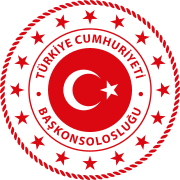Emblems of Turkey
This article has multiple issues. Please help improve it or discuss these issues on the talk page. (Learn how and when to remove these messages)
|
| National Emblem of the Republic of Turkey | |
|---|---|
 | |
| Armiger | Republic of Turkey |
| Adopted | 1936[citation needed] |
| Shield | A crescent and mullet gules |
| Use | Turkish passport, Turkish ID card, Ministry of Foreign Affairs (Turkey) |


Turkey has no official national emblem, but the crescent and star (Turkish: ay-yıldız, lit. 'crescent-star') design from the national flag is in use on Turkish passports, Turkish identity cards and at the diplomatic missions of Turkey.
The crescent and star are from the 19th-century Ottoman flag (1844–1923) which also forms the basis of the present-day Turkish flag. Following the abolition of the Sultanate on 1 November 1922, the Ottoman coat of arms was no longer used and the crescent and star became Turkey's de facto national emblem. In the national identity cards of the 1930s the horns of the crescent were facing left, instead of the now more common orientation towards right.[1]
History
[edit]The coat of arms of the Sultan was abolished from usage after the abolition of the Ottoman sultanate in 1922. In its stead, the star and crescent on the flag was adopted. Three years later, in 1925, Ministry of Education opened a contest for determining another official coat of arms and artist Namık İsmail's design won.[2][3] İsmail's design featured a red shield charged with a white star and crescent. Underneath there was a grey wolf, connected to Oghuz Turkic mythology, standing on a spear. The shield was surrounded by a garland of wheat and oak leaves, with a medallion depicting Ottoman alphabet letters T and C for Türkiye Cumhuriyeti, Republic of Turkey. Above the shield was placed a lit torch, symbolising the country's independence.[4] However, the new coat of arms was never registered as an official coat of arms, and was never used subsequently.[3] A 2014 government review to develop a coat of arms has yet to result in a design, as of 2015.[5][6]
-
Namık İsmail's proposed design
Use by government bodies
[edit]Red circle with white star and crescent
[edit]A circular section of the red flag of Turkey containing the white crescent and star is used in the current emblems of a number of Turkish ministries and governmental institutions, in the emblem of the Grand National Assembly, and as the flag badge on the uniforms of Turkish national sports teams and athletes. It was also used on the old (non-digital) Turkish identity cards.[7]
-
Circular flag used as a badge by the national sports teams and athletes, and for other semi- and quasi-official purposes
-
Seal of the Grand National Assembly (parliament)
-
Seal of the Prime Ministry (historic)
Coat of arms of the Ministry of Foreign Affairs
[edit]
The Turkish Ministry of Foreign Affairs often uses a red oval-shaped escutcheon which takes its colour from the Turkish flag, while its shape echoes the oval shield at the center of the late 19th-century Ottoman coat of arms.[8] The escutcheon contains a gold-tone crescent and star which are vertically oriented (with the star on top) and surrounded by the gold-tone text T.C. Dışişleri Bakanlığı.[9] A variant of this oval escutcheon (containing the gold-tone text Türkiye Cumhuriyeti Büyükelçiliği) is used by the Turkish embassies.[10][11]
-
Seal of the Ministry of Foreign Affairs
-
Variant used by the Embassies
-
Variant used by the Consulate-Generals
Presidential seal
[edit]The seal of the president of Turkey has a large 16-pointed star in the center, which is surrounded by 16 five-pointed stars, symbolizing the 16 Great Turkic Empires.[12] Its appearance is regulated by law.
-
Presidential Seal of Turkey
-
Presidential with no background
See also
[edit]References
[edit]- ^ National ID card of Mustafa Kemal Atatürk from 1934
- ^ Pâkalın, Mehmet Zeki (1954). "Namik Ismail bu son nümune üzerinde ufak bir tadil yapti ve son sekil". Osmanlı tarih deyimleri ve terimleri sözlüǧü (in Turkish). Vol. 1. M.E.B. Devlet Kitapları. p. 8. Retrieved 17 November 2011.
- ^ a b "Arma". Aksiyon Dergisi (in Turkish) (373). 2002. Archived from the original on 2005-02-27. Retrieved 20 February 2015.
Cumhuriyetin ilk yıllarında Türkiye'nin kendi armasını yapmak için girişimler olmuş. Ancak bir türlü hayata geçirilemeyen bu proje kapsamında, 1927 yılında Milli Eğitim Bakanlığı tarafından bir yarışma açılmış. Birçok eserin katıldığı yarışmada Namık İsmail'in arması birincilik almış. Diğer tüm armalar gibi kalkan içerisinde bulunan armanın zemini kırmızıymış. Merkezinde Türk Bayrağını temsil eden ay yıldızın bulunduğu armanın alt kısmında Oğuz menkıbesini simgeleyen bir kurt resmi bulunuyormuş. Kurdun ayaklarının altında ise eski bir Türk silahı 'harbe' bulunuyormuş. Kalkanın altında bulunan İstiklal Madalyası ise harbi ve bunun neticesini muhafaza etmeyi simgeliyormuş. Başak ve meşe yapraklarıyla sarılı armanın ortasında ise Türkiye Cumhuriyeti'ni simgeleyen T.C harfleri varmış. Ancak Mustafa Kemal Atatürk'ün de çok istediği bu arma bir türlü resmi şekle sokulamadı.
- ^ "türkiye cumhuriyeti arması baki sarısakal". paperzz.com. Retrieved 2022-09-10.
- ^ "Turkey in search of a coat of arms to serve as national symbol". Daily Sabah. 2014-12-17. Retrieved 2023-05-20.
- ^ "Türkiye Cumhuriyeti'nin resmi arması belirlenecek". www.trthaber.com (in Turkish). 2015-01-14. Retrieved 2023-10-24.
- ^ "Specimen of the old (non-digital) Turkish identity card". Archived from the original on 2016-03-09. Retrieved 2023-11-06.
{{cite web}}: CS1 maint: bot: original URL status unknown (link) - ^ "Republic of Türkiye Ministry of Foreign Affairs". www.mfa.gov.tr.
- ^ "Official escutcheon of the Ministry of Foreign Affairs of the Republic of Turkey". Archived from the original on 2016-03-04. Retrieved 2012-11-16.
- ^ "Official escutcheon of the Turkish Embassies". Archived from the original on January 26, 2013.
- ^ "Official escutcheon of the Turkish Embassies". Archived from the original on 2016-03-04. Retrieved 2012-11-16.
- ^ "Official website of the Turkish Presidency: Detailed description of the Turkish Presidential Seal". Archived from the original on 2011-10-04. Retrieved 2009-05-06.








